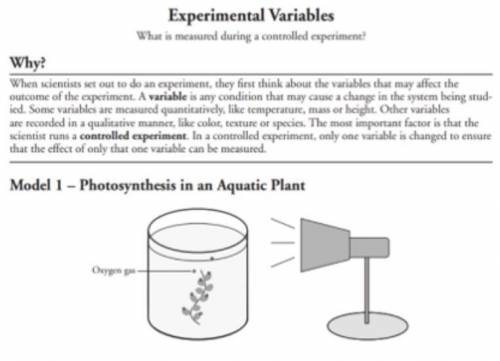
Biology, 21.08.2020 17:01 zhellyyyyy
The diagram in model 1 illustrates a clipping of an aquatic plant in water.
a. what process is occurring in the plant's cells to produce the gas in the bubbles that appear?
b. what gas is the plant producing?
c. what source of energy is the plant using to conduct the process recorded in part a?


Answers: 1
Another question on Biology

Biology, 21.06.2019 19:00
Florian discovers a rock that is broken into pieces. each piece has several bands. which type of rock does florian predict these pieces will change into when subjected to heat and pressure? igneous magma metamorphic sedimentary
Answers: 1

Biology, 22.06.2019 01:10
Determine if the following statement is true or false. if true, choose true. if false, choose the rewording that is true. according to the law of independent assortment, alleles for each gene are inherited together so that they always stay together. according to the law of independent assortment, offspring express a combination of their parents' traits. according to the law of independent assortment, alleles for a characteristic split during meiosis and combine during fertilization. true according to the law of independent assortment, alleles for each gene are inherited independently so that no two alleles stay together.
Answers: 1

Biology, 22.06.2019 03:30
State officials are considering constructing a road through a forested wilderness area. this action will likely affect the forest ecosystem in various ways. part a: predict how the construction of a road could negatively affect plants and animals in that ecosystem. (3 points) part b: describe one way that the construction of a road could have a positive impact of the forest ecosystem. (1 point)
Answers: 1

Biology, 22.06.2019 05:30
Can bacteria reproduce in a way such that when you start out with two bacteria, you get five bacteria? why or why not? * a. yes, because bacteria reproduce sexually, and can produce any number of offspring, just as humans do. b. no, because bacteria grow at an exponential rate. c. no, because when bacteria reproduce, they split into two parts, and two bacteria splitting would result in four bacteria.
Answers: 1
You know the right answer?
The diagram in model 1 illustrates a clipping of an aquatic plant in water.
a. what process is occu...
Questions

Engineering, 25.05.2021 05:00

English, 25.05.2021 05:00

Mathematics, 25.05.2021 05:00


Computers and Technology, 25.05.2021 05:00

Physics, 25.05.2021 05:00


Mathematics, 25.05.2021 05:00






English, 25.05.2021 05:00









